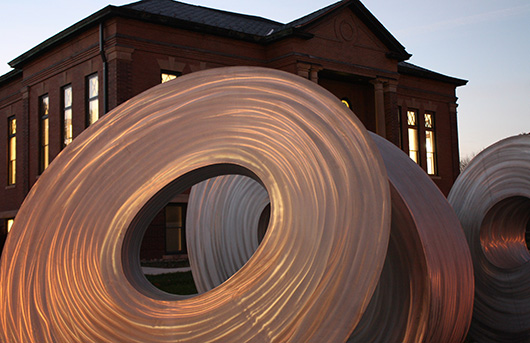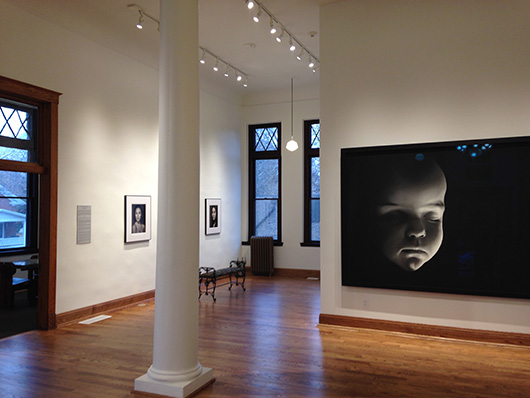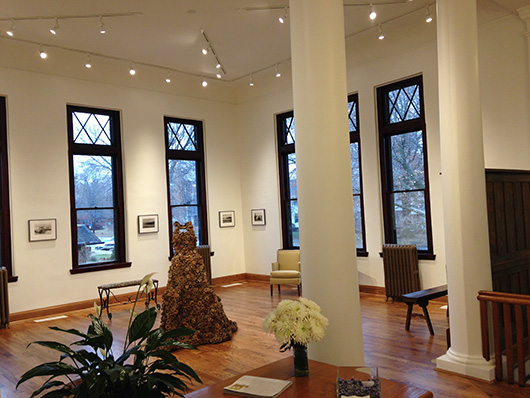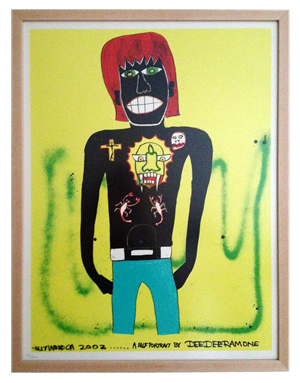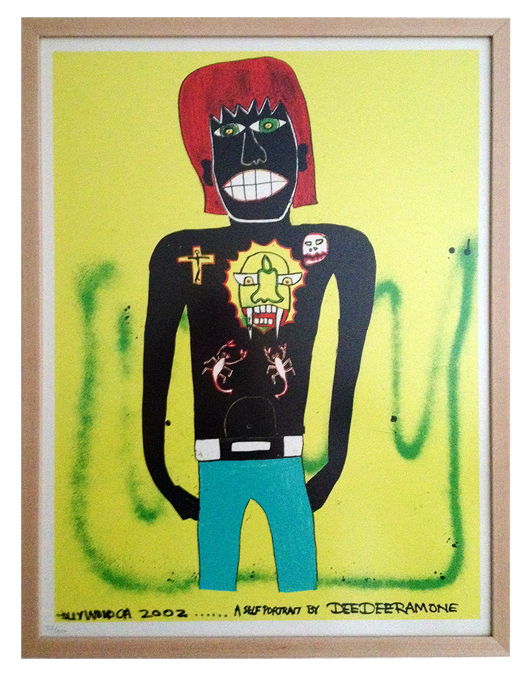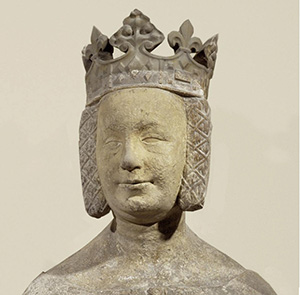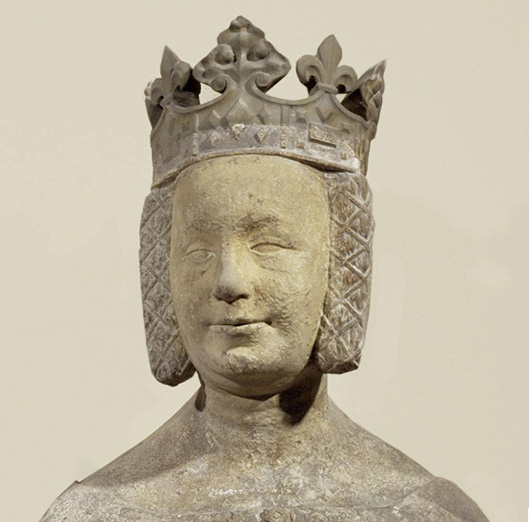
It was a classy building – all bricks and stained glass. She used to open the heavy front door and race up the wooden staircase beneath a portrait of an old rich guy named Andrew Carnegie, who must have loved books as much as she did. He’d donated a lot of money to have the library built, back in 1908.
Karen spent hours at a time there, week after week, year after year. She read most of the stories on the shelves and daydreamed about more. But even she never imagined how her own adventures would bring her back here years later. She never guessed that someday her own portrait would hang above the staircase, too, The Des Moines Register reported.
As Karen grew, she spent a little less time at the library and a little more with a boy named Bobby Duncan. They went on their first date in junior high. They fell in love. They got married and had two kids, named Paige and Todd.
By now the Duncans lived in Lincoln, Nebraska, and Bobby – now Robert – went to work fixing airplanes for his dad’s company, Duncan Aviation. He eventually took it over and turned it into the biggest family-owned plane maintenance business in the world.
Meanwhile, Karen played the piano, managed the Nebraska Chamber Orchestra and often dragged Robert to concerts. She joined the board of the University of Nebraska-Lincoln’s Sheldon Museum of Art and dragged him there, too.
But Robert also took an interest in art, and soon the couple started building a collection of their own, starting in the late 1970s. They visited galleries. They went to auctions and art fairs. They bought an abstract sculpture by Georgia O’Keeffe – their first big purchase – and gradually amassed almost 2,000 works by the likes of Louise Bourgeois, Bruce Nauman and Kiki Smith.
Former Sheldon director George Neubert ranked the collection among the country’s 50 best in a Wall Street Journal profile about the Duncans earlier this year.
The collection outgrew the Duncans’ house, so they spread it out. They loaned some to their son, Todd, who took over the aviation business when Robert retired. They loaned some more to their daughter, Paige, who runs Clarinda’s branch of Bank Iowa, the other family business.
The Duncans moved some of their artwork to their second home, in Mexico, and to Duncan Aviation’s offices in Michigan and Utah. With another couple, they opened a gallery near downtown Lincoln, called The Assemblage, to display even more artwork, including the stuff both couples brought back last year from a three-week, 12-country spree through South America.
Karen was chopping vegetables in the kitchen two years ago when her assistant, Susan Roth, came up from the basement with a declaration: They needed to do something about the books. Stacks of them had taken over the house. There were so many, in fact, that Susan suggested constructing a storage building on the Duncans’ 40-acre property.
But Karen did her one better. She suggested buying an old, empty Carnegie library from somewhere and hauling it in. She knew of at least two in town that had been moved from their original locations and converted for other uses. One was a soup kitchen. The other housed an engineering office.
So the two women looked online for libraries for sale, and wouldn’t you know it? Up popped the one in Clarinda, where Karen had spent so much of her childhood. It had served as a library until 2004, when the town built a new one down the street.
The old building was to be sold at an auction – the next day.
“It almost puts a shiver through you, doesn’t it?” Karen said.
She made a few calls. The auctioneer told her the library might sell for as little as $20,000. The building-mover she found told her he couldn’t haul it to Nebraska because it would be too heavy for the Missouri River bridge.
But Robert told her they should buy it anyway. And so they did, for $33,000.
The Duncans tossed around a few different ideas for the old building but didn’t take too long to settle on an art museum. For years they had rotated their art collection among their family’s homes, their offices and the Lincoln gallery. So they figured they could just add the new museum to the rotation. Their gallery curator in Lincoln could send over a new batch of work every six months.
So the Duncans spent about $1 million to spiff up the building to its former glory. Work crews refinished the hardwood floors and re-installed some of the bookcases. They pulled the original chandeliers out of the attic. They repaired the windows and replaced six of them after a hailstorm this summer.
A roomy new elevator went in. A new patio opened out back. A Steinway baby grand piano was wrestled up the front steps and rolled into a corner for recitals and receptions.
Every choice was deliberate. Every detail was just so.
Finally, more than 700 people in this town of 5,000 showed up on Nov. 9 for the grand opening of the Clarinda Carnegie Art Museum.
They climbed the polished steps and saw a 6-by-7-foot portrait of a baby’s face, drawn in soft charcoal. They admired a sculptural dress made from 1,000 pinecones. They watched an odd video of a man smiling, painfully, for a solid hour.
That sort of artwork is rare in small towns. But at the opening, the building itself was the real star.
“It’s lovely,” said Mildred Jensen, who recently revisited without the crowds. “It has a second life. They’ve got it so bright. You can get in and enjoy it.”
A book club from Des Moines drove down for a tour with the museum’s director, Trish Okamoto. A woman named Sharon Yahnke stopped by, too, during a 30-mile trip from Sidney.
“It’s just a great destination,” she said. “For me, just like everybody else who grew up in small-town America, the Carnegie library was just part of my life. You’re always glad to see them put to good use.”
And nobody is more glad than Karen. She doesn’t bike to the building much anymore, but she’s still a frequent visitor. Sometimes she and Robert, now in their early 70s, fly in from Lincoln in one of their planes. One is plaid. Another is bright green with Jackson Pollock-y splatters.
It all sounds like a story she might have pulled from the old bookshelves, except it’s true.
“Everybody in town has been really great with this whole adventure,” Karen said. “I think everybody is pleased with the art, and we’ve had so many people thank us for saving the building.”
But the new project didn’t solve the problem at home.
“We still don’t have anywhere to put the books,” she said. “They’re all still down in the basement.”
___
Information from: The Des Moines Register, http://www.desmoinesregister.com
Copyright 2014 Associated Press. All rights reserved. This material may not be published, broadcast, rewritten, or redistributed.
AP-WF-12-04-14 1414GMT
ADDITIONAL IMAGES OF NOTE
